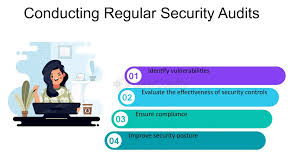Explore the Latest Cyber Defense Strategies
In today’s digital world, protecting your information and systems from cyber threats is crucial. With new threats emerging constantly, staying updated on the latest cyber defense strategies is essential. This article will explore the most effective cyber defense strategies available today, helping you understand how to keep your digital assets secure.
Implementing Advanced Threat Detection Systems
Advanced threat detection systems are essential for identifying and responding to cyber threats. These systems use sophisticated technology to monitor network traffic and detect unusual behavior that might indicate a security breach. By analyzing patterns and anomalies, they can pinpoint potential threats before they cause significant damage.
Advanced threat detection systems often use artificial intelligence and machine learning to improve their accuracy. These technologies allow the system to learn from past incidents and recognize new types of threats. For example, if a system detects an unusual amount of data being transmitted from an unexpected location, it can flag this as suspicious and alert security teams.
Implementing these systems involves integrating them into your existing network infrastructure. This may require specialized software and hardware, as well as regular updates to keep the system effective against new threats. It’s also important to ensure that your team is trained to interpret the alerts generated by these systems and take appropriate action.
Adopting Multi-Factor Authentication
Multi-factor authentication (MFA) adds an extra layer of security by requiring users to provide more than one form of identification before gaining access to systems. Instead of just a password, users might need to enter a code sent to their phone or use a fingerprint scan.
MFA significantly reduces the risk of unauthorized access. Even if a hacker manages to steal a password, they would still need the additional authentication factor to gain access. This makes it much harder for cybercriminals to breach your systems.
To implement MFA, you need to choose a method that fits your organization’s needs. Common options include SMS codes, email confirmations, or biometric methods. Integrating MFA into your login process may involve configuring settings on your existing platforms and educating users on how to use the new system effectively.
Regularly Updating and Patching Software
Regularly updating and patching software is a fundamental part of maintaining cybersecurity. Software updates often include fixes for security vulnerabilities that could be exploited by attackers. Keeping your software up-to-date ensures that you are protected against known threats.
Many organizations struggle with keeping track of all their software and ensuring that updates are applied in a timely manner. To address this, consider using automated patch management tools that can scan your systems, identify outdated software, and apply updates automatically.
It’s also important to review the security policies for each software application. Some applications may require manual updates or specific configuration settings to ensure they are secure. Regularly checking for and applying updates is a proactive step in defending against cyber threats.
Conducting Regular Security Audits

Regular security audits are essential for identifying weaknesses in your cyber defense strategies. These audits involve a comprehensive review of your security practices, systems, and protocols. By assessing your current security posture, you can find areas that need improvement and address potential vulnerabilities.
A typical security audit includes evaluating your network architecture, reviewing access controls, and testing your incident response procedures. It may also involve checking for compliance with relevant regulations and standards. Engaging with third-party security experts can provide an objective assessment and offer valuable insights into how you can strengthen your defenses.
Conducting regular audits ensures that your security measures are up-to-date and effective. It’s important to schedule audits at least annually or whenever significant changes are made to your systems. This ongoing evaluation helps you stay ahead of emerging threats and maintain a strong security posture.
Educating Employees on Cybersecurity Best Practices
Employees play a crucial role in maintaining cybersecurity. Educating them on best practices helps prevent accidental breaches and ensures that they are aware of potential threats. Training should cover topics such as recognizing phishing emails, creating strong passwords, and understanding safe internet practices.
Regular cybersecurity training sessions can keep employees informed about the latest threats and security measures. Simulated phishing attacks and interactive training modules can make learning engaging and effective. It’s also important to establish clear guidelines for reporting suspicious activity and provide support for employees who may have concerns.
By fostering a culture of cybersecurity awareness, you empower your employees to act as a first line of defense against cyber threats. Ongoing education helps create a more secure environment and reduces the risk of human error leading to security breaches.
Establishing a Comprehensive Incident Response Plan
An incident response plan outlines the steps to take when a security breach or cyber attack occurs. Having a well-defined plan helps minimize damage, recover quickly, and learn from the incident to improve future defenses.
A comprehensive incident response plan typically includes the following components:
- Preparation: Establishing procedures, assigning roles, and ensuring resources are in place.
- Detection and Analysis: Identifying and assessing the nature of the threat.
- Containment, Eradication, and Recovery: Implementing measures to contain the threat, remove it, and restore normal operations.
- Post-Incident Review: Analyzing the incident to understand what happened and how to prevent similar incidents in the future.
Regularly testing and updating your incident response plan is essential to ensure its effectiveness. Conducting drills and simulations can help your team practice their response and refine procedures.
Using Encryption for Data Protection
Encryption involves converting data into a coded format that can only be read by authorized individuals. By encrypting sensitive information, you protect it from unauthorized access, even if it is intercepted or stolen.
Encryption can be applied to data at rest (stored data) and data in transit (data being transmitted). For instance, encrypting files stored on a hard drive ensures that they remain secure if the device is lost or stolen. Similarly, encrypting data sent over the internet protects it from being intercepted by attackers.
Implementing encryption involves selecting the appropriate encryption algorithms and protocols for your needs. It also requires managing encryption keys securely to ensure that only authorized users can access the encrypted data.
Implementing Zero Trust Architecture
Zero Trust Architecture (ZTA) is a security model that assumes no implicit trust within the network. Instead, it requires continuous verification of users and devices before granting access to resources. The principle behind Zero Trust is that trust should never be assumed, regardless of the user’s location or device.
In a Zero Trust model, access is granted based on the identity and context of the request. This includes factors such as user identity, device security posture, and the sensitivity of the requested resource. Access controls are enforced at multiple levels, including the network, application, and data.
Implementing Zero Trust involves redefining access policies, deploying identity and access management solutions, and integrating monitoring and analytics tools to detect and respond to potential threats. It requires a shift in mindset from traditional perimeter-based security to a more dynamic and granular approach.
Regularly Backing Up Critical Data
Regularly backing up critical data is a fundamental strategy for protecting against data loss due to cyber attacks, hardware failures, or other disasters. Backups ensure that you can restore your systems and data to a known good state in the event of a problem.
Effective backup strategies include:
- Frequent Backups: Performing regular backups to ensure that recent data is saved.
- Multiple Copies: Storing backups in different locations, such as on-site and off-site or in the cloud, to protect against local disasters.
- Testing Backups: Regularly testing backup procedures to ensure that data can be restored successfully when needed.
A robust backup plan helps mitigate the impact of cyber incidents such as ransomware attacks, where data may be encrypted or held hostage. By having reliable backups, you can recover your data and resume operations with minimal disruption.
Conclusion
Exploring the latest cyber defense strategies is essential for safeguarding your digital assets. Implementing advanced threat detection systems, adopting multi-factor authentication, regularly updating and patching software, conducting security audits, and educating employees are all crucial steps in building a robust cybersecurity posture. By staying informed and proactive, you can better protect your organization from the ever-evolving landscape of cyber threats.



